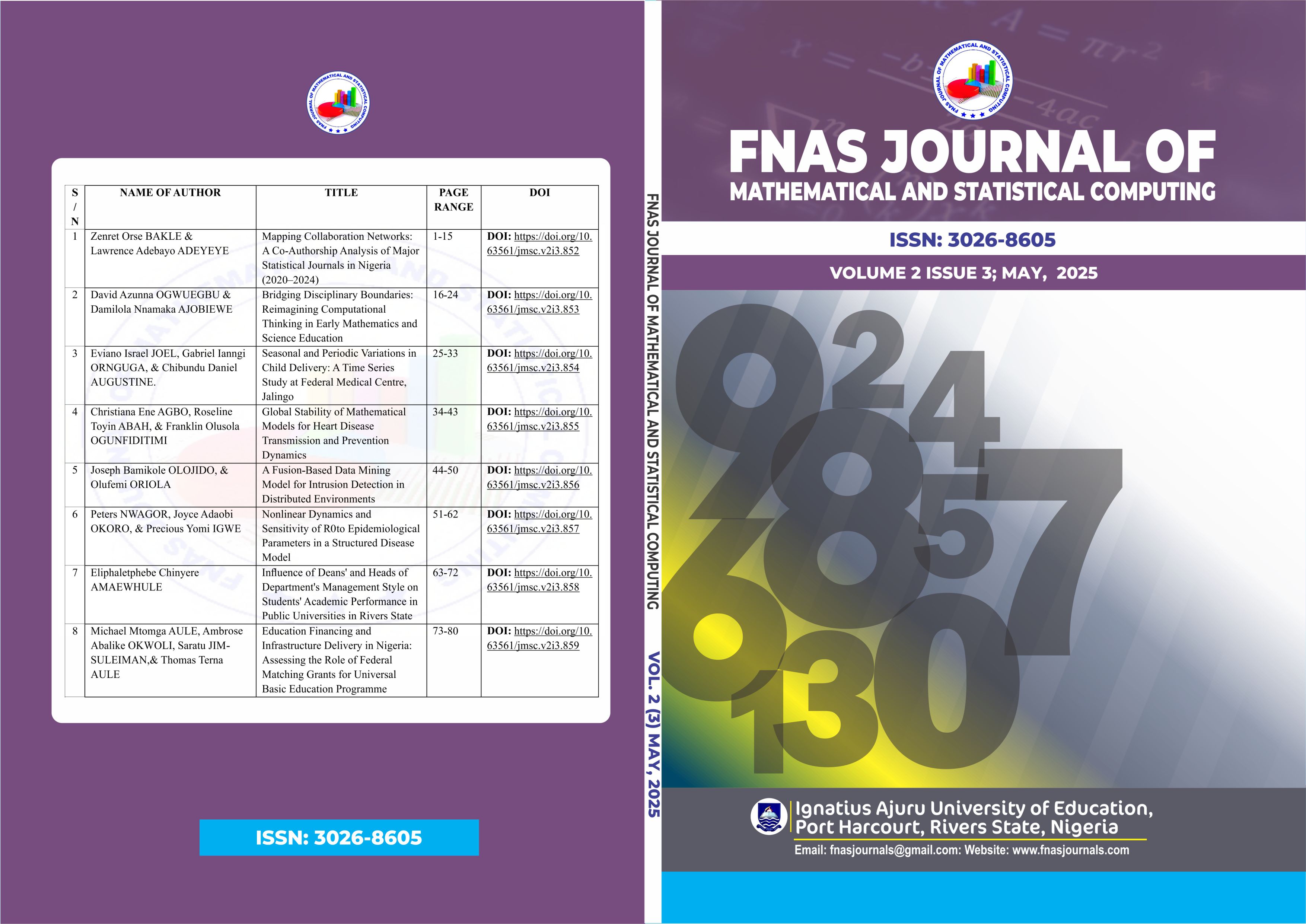Seasonal and Periodic Variations in Child Delivery: A Time Series Study at Federal Medical Centre, Jalingo
Main Article Content
Abstract
This study examines seasonal and periodic fluctuations in the modes of child birth especially spontaneous vaginal delivery (SVD), planned cesarean section (CS), and emergency CS—at the Federal Medical Centre (FMC), Jalingo, Nigeria, using a ten-year monthly dataset (2015–2024). Employing a time series analytical framework in STATA 15, the study utilized Augmented Dickey-Fuller (ADF) and Phillips-Perron (PP) tests to confirm stationarity and applied Vector Autoregression (VAR) to assess interdependencies among delivery modes. Descriptive analysis revealed marked seasonal variations: SVD peaked in February (mean = 9.89) and November (mean = 10.00), planned CS recorded its highest average in July (mean = 11.68), and emergency CS exhibited a major spike in March (mean = 11.26; maximum = 50 cases). ADF and PP results indicated all series were stationary (p < 0.001). The optimal model (Lag 1) was selected based on AIC and FPE criteria. VAR estimates demonstrated strong autoregressive and cross-sectional effects: prior SVD significantly predicted current SVD (β = 0.3739, p < 0.001), while prior emergency CS strongly predicted planned CS (β = 0.2349, p < 0.001). Additionally, emergency CS was influenced by prior SVD (β = 0.1988, p = 0.004) and planned labor stimulation (β = 0.2151, p = 0.006). Model diagnostics confirmed robustness, with no residual autocorrelation (p = 0.379). These findings highlight the influence of cultural, climatic, and institutional factors on delivery trends, offering actionable insights for maternal healthcare planning, resource allocation, and emergency preparedness. Strategic scheduling and preventive interventions during high-demand months are recommended to optimize obstetric care.
Article Details
References
Abenhaim, H. A., Azoulay, L., & Benjamin, A. (2008). Effect of weekend delivery on obstetric interventions. Obstetrics & Gynecology, 111(4), 974 – 981.
Adedokun, B. O., Uthman, O. A., &Adekanmbi, V. T. (2018). Seasonal variation in birth outcomes: A systematic review and meta-analysis. BMC Public Health, 18(1), 1–12.
Basu, R., Malig, B., &Ostro, B. D. (2010). High ambient temperature and the risk of preterm delivery. American Journal of Epidemiology, 172(10), 1108 – 1117. DOI: https://doi.org/10.1093/aje/kwq170
Box, G. E. P., Jenkins, G. M., Reinsel, G. C., &Ljung, G. M. (2015). Time Series Analysis: Forecasting and Control (5th ed.). Wiley.
Bruckner, T. A., Mortensen, L. H., & Catalano, R. A. (2007). Is the seasonal pattern in births a result of seasonal variation in conception? Social Science & Medicine, 65(3), 580 – 590.
Chauhan, S. P., Martin, J. N., & Morrison, J. C. (2015). Cesarean delivery rates: Toward understanding variation. Obstetrics & Gynecology, 126(5), 953 – 959.
Chung, T. K., Lau, T. K., & Yip, A. S. (2011). Sociocultural factors influencing the mode of delivery in Chinese women. European Journal of Obstetrics & Gynecology and Reproductive Biology, 95(1), 43 – 48.
Fapohunda, B. M., &Orobaton, N. G. (2014). When women deliver with no one present in Nigeria: who, what, where and so what? PLoS One, 8(7), e69569. DOI: https://doi.org/10.1371/journal.pone.0069569
Goldenberg, R. L., McClure, E. M., Bhutta, Z. A., Belizán, J. M., Reddy, U. M., Rubens, C. E., & Darmstadt, G. L. (2008). Stillbirths: the vision for 2020. The Lancet, 370(9601), 1798 – 1805. DOI: https://doi.org/10.1016/S0140-6736(10)62235-0
Katz, M., Wang, J., & Chia, Y. C. (2011). Seasonal variation in cesarean section rates: A retrospective review. Birth, 38(3), 224 – 229.
Liu, H., Li, Y., & Wang, W. (2019). Seasonal variation in cesarean deliveries and their association with maternal and neonatal outcomes. BMC Pregnancy and Childbirth, 19(1), 222.
Macfarlane, A., Dattani, N., & Gibson, R. (2015). Birth counts: The timing of delivery and the time of birth of babies in England and Wales. Health Statistics Quarterly, 53, 10 – 23.
Okonofua, F. E., Ogu, R. N., Ntoimo, L. F. C., Galadanci, H. S., &Gana, M. (2009). Assessing the role of health system challenges in reducing maternal mortality in Nigeria. African Journal of Reproductive Health, 13(3), 131 – 139.
Oladapo, O. T., Sotunsa, J. O., Sule-Odu, A. O., & Daniel, O. J. (2010). Trends in the incidence of eclampsia and pre-eclampsia in a Nigerian hospital. Journal of Obstetrics and Gynaecology, 30(5), 432 – 436.
Onwuhafua, P. I., Ocheke, A. N., &Onwuhafua, A. (2012). Seasonal variation in obstetric deliveries in a tropical region. Journal of Medicine in the Tropics, 14(1), 23 – 26.
Parazzini, F., La Vecchia, C., & Negri, E. (2003). Risk factors for cesarean section in Italy. British Journal of Obstetrics and Gynaecology, 97(1), 70 – 75.
Zhang, W., Zhao, J., & Yang, J. (2020). The relationship between climate factors and the mode of childbirth: A time-series analysis in China. International Journal of Environmental Research and Public Health, 17(9), 32 – 70.

